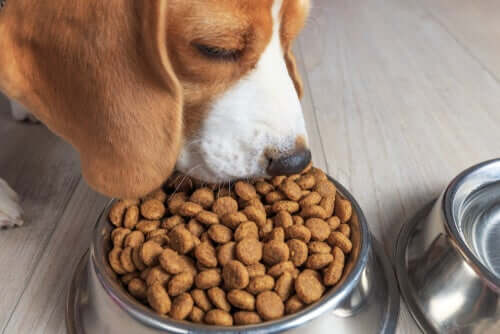3 Things You Didn't Know About Your Dog's Food

When it comes to our pets, we should pay as much attention to their diet as we do our own. After all, your dog’s food can have a huge impact on its health. However, the world of pet food is much more complex than it might seem. There are a lot of aspects that can seem confusing to owners if they don’t have all the information they need beforehand.
The list of ingredients and nutrients in dog food is just as overwhelming as the information on human food. The lists seem never-ending, and full of unfamiliar, unpronounceable substances. But there’s no need to worry. Just like our food, every pet food is subjected to thorough quality control tests.
In this article, we’ll take a look at some of the things you probably didn’t know about your dog’s food. That way, hopefully you won’t feel quite so lost the next time you decide to take a look at the ingredients.
Your dog’s food can contain heavy metals
Yes, you read that right. But this is no bad thing, as long as it’s controlled. Many natural ingredients contain heavy metals, but because they’re present in such small amounts (usually no more than a few parts per million), they’re beneficial rather than harmful.
This is an important fact for owners to know. Understandably, many people would be concerned to find that the pet food they bought from the store contained metals such as lead, mercury, arsenic and cadmium. It would be logical to think that they could even poison your dog. Fortunately, however, this isn’t the case. The quantity of heavy metals is carefully controlled, and will never be anywhere near enough to pose a danger to your pet’s health.

In fact, cutting those heavy metals out of your pet’s diet is simply impossible. They’re present in the air, water and the earth, where they’re naturally absorbed by both plants and animals, including you and your pets.
Ash in pet food
When owners look at the ingredients of dog food, one of the things that attracts their attention most is the fact that many recipes contain a certain amount of ash. While you may think it may be harmful to your dog’s health, it’s actually essential for keeping their mineral levels at 100%.
In fact, the “ash” present in pet food isn’t actually ash at all. It’s simply a technical term to describe the amount of minerals in the recipe. This includes minerals such as iron, zinc or calcium, all of which are essential for the body to function properly. A lack of minerals in your pet’s diet can cause problems in the bones and other bodily tissues.
So, without this ash in your dog’s food, they may suffer from developmental issues. In addition to this, their bones may not be as strong as they should be. On the other hand, too much ash can cause problems in the gastrointestinal tract, cause damage to the kidneys, or crystals in the urine.
The problem with too much wet food
It’s becoming more and more common for owners to feed their pets wet food. The famous tins of dog food are sold in every supermarket around the world. However, the majority of tinned foods are not as nutritional as they might seem, even if your dog prefers them.

As well as containing half the amount of ash present in dry food, wet food can also cause dental problems. While crunching up dry food helps clean tartar from the teeth, wet food allows it to build up. If you want to feed your pet wet food, it’s best to alternate with dry food to keep their teeth clean and healthy.
Finally, if your dog is prone to weight gain, it’s important to pay special attention to the amount of wet food in their diet, as it generally has a higher fat and calorie content than dry food. Remember, moderation is the key.
All cited sources were thoroughly reviewed by our team to ensure their quality, reliability, currency, and validity. The bibliography of this article was considered reliable and of academic or scientific accuracy.
- Flipa. Curiosidades sobre la alimentación de los perros que quizás no conocías. Extraído de: https://www.flipa.net/curiosidades-sobre-alimentacion-de-perros/
- El espectador. Lo que no sabías sobre el alimento para tu mascota. Redacción Cromos. 12 de julio de 2018. Extraído de: elespectador.com/cromos/estilo-de-vida/lo-que-no-sabias-sobre-el-alimento-para-tu-mascota-articulo-799844
- Tienda animal. Cenizas en pienso para perros. Extraído de: https://www.tiendanimal.es/articulos/cenizas-en-pienso-para-perros/